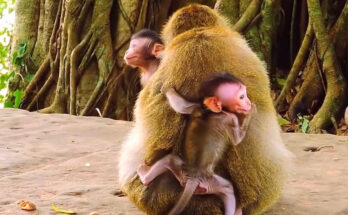Hidden Danger in the Trees: How Baby Monkeys Can Choke on Fruit and Die If Not Rescued in Time
In the lush canopies of tropical forests, baby monkeys play, explore, and learn the ways of the wild under the watchful eyes of their mothers. However, few realize that one of the greatest threats to these young primates comes not from predators or deforestation, but from something as seemingly harmless as fruit.
Fruit is a primary food source for many monkey species. It’s sweet, nutritious, and abundant in their natural habitat. But for baby monkeys, especially those just beginning to wean and eat solid foods, fruit can pose a serious choking hazard. Without the motor skills, experience, or jaw strength to properly chew or manipulate larger chunks of fruit, they can easily get pieces lodged in their throats.
This is not a rare or trivial occurrence. Wildlife rescue centers around the world, particularly in parts of Asia, Africa, and South America, have documented numerous cases where orphaned or even mothered baby monkeys choked on food—most often soft fruits like bananas, mangoes, or guavas. In many cases, these incidents are fatal unless intervention happens immediately.
Why Does This Happen?
Young monkeys learn how to eat by mimicking their mothers. In natural conditions, the mother might pre-chew food or offer smaller, manageable pieces. But when babies are orphaned—often due to habitat loss, poaching, or accidents—they don’t get the benefit of this learning period. In rescue centers or in the wild, if they’re forced to feed themselves too early, they can overestimate their ability to swallow larger chunks of food.
Additionally, their small airways and immature swallowing reflexes make them more prone to choking. Unlike human children who might be supervised and receive the Heimlich maneuver in emergencies, baby monkeys often have no one to help unless a human caregiver is nearby and trained to respond.
The Role of Rescue Centers
Sanctuaries and wildlife rehabilitation centers play a critical role in preventing such deaths. Caregivers are trained to monitor feeding times closely, offer fruit in safe sizes, and intervene when a choking incident occurs. Some centers have protocols in place for emergency response, including suction tools or special techniques to dislodge stuck food.
Rescue centers also emphasize slow weaning, ensuring that baby monkeys gradually transition to solid foods under close observation. When possible, surrogate monkey mothers or older juveniles help teach the babies how to eat safely—recreating a more natural learning environment.
What You Can Do
Public awareness is essential. Tourists who feed monkeys in the wild, often with large pieces of fruit or processed food, unknowingly put young monkeys at risk. If you encounter monkeys in the wild, it’s best not to feed them at all. Instead, support local rescue efforts, donate to rehabilitation centers, or sponsor a baby monkey’s care.
Choking may seem like a minor threat in the grand scheme of wildlife conservation, but for a baby monkey, it can mean the difference between life and death. With informed care and timely rescue, these tiny primates can grow up safely, swinging through the trees as nature intended.



